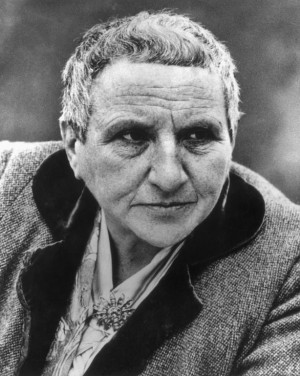Appreciating the genius of Gertrude Stein.

Oh, my goodness, I love Gertrude Stein — as a thinker, a writer, and an American. And I want to make a claim on her. I want to say that the only thing she would find more abhorrent than complete obscurity would be the kind of off-handed ignorant cliché of the “a rose is a rose is a rose” kind of recognition she receives today.
It’s like knowing or judging R. Crumb from “Keep on Truckin'!” There is a reason why Pablo Picasso and Henri Matisse and Ernest Hemingway, etc., were associated with her for so long. I want everyone to reimagine Gertrude Stein for the video century.
Gertrude's chief forgotten attribute as a thinker, artist, writer is what makes her most American to me. She trained with William James at his Harvard psychological studies in the 1890s. As a result of that work, she had scientifically broken down the real, natural world and the plastic, artistic visual world, into a scintillating mantra for every artist subsequent to her. She had this secret weapon in her toolkit before she met Pablo Picasso, and if it isn't the most potent artistic formula ever produced by humanity, it's near the top.
“Endless repetition, infinite variation” is perceptible in seeds, eggs, skin, muscle, sinew, leaves, waves, seasons, human life cycles, societal life cycles, and pretty much all cycles of time conceivable. Endless repetition, infinite variation is the message and the manner of DNA, the rotations of galaxies, the quanta of subatomic activity. Endless repetition, infinite variation is the six basic shapes of the universe: hexagon, lattice, spiral, sphere, branch, and meander.
Endless repetition, infinite variation is the perpetual motion of each individual psychology and the style of Gertrude's prose. Anyone who follows her on her linguistic journeys learns to think and receive in three dimensions, like a magic eye in motion.
I've taken one particular journey, with Gertrude’s The Making of Americans, although I can't claim to have completed the whole 1,000 pages of text. I did read all of an essay that she wrote in 1935 called “The Gradual Making of the Making of Americans,” which explained her approach:
“I then began again to think about the bottom nature in people, I began to get enormously interested in hearing how everybody said the same thing over and over again with infinite variations but over and over again until finally if you listened with great intensity you could hear it rise and fall and tell all that there was inside them, not so much by the actual words they said or the thoughts they had but the movement of their thoughts and words endlessly the same and endlessly different.”
That's from a lovely 1962 Vintage edition, edited by Carl Van Vechten, with Picasso's Gertrude on the cover. I hear Sherwood Anderson in that, and Ernest, and a whole bunch of other macho writers who had no conception of endless repetition, infinite variation, until the idea was transformed by Andy Warhol into pop art, which Lou Reed, Jonathan Richman, and my father, D. Selby Fing, picked up on, too. Take a riff and go with it, let it wend its way into the world, repeat it, find your own way to endlessly repeat and infinitely vary. I see that resonating from Gertrude throughout the 20th century, and I feel it in the rhythms of my artistic life.
This is one sentence from The Making of Americans, describing Miss Charles:
“These have it in them then to have when they have quick reaction in them that is not a stirring from the depths of them these have it very often that this in them is a violent attacking, often continuous dragging, often moral reforming convention, often nervous action in them, often incessant talking, incessant action, incessant attacking in them and this is in those of them that are the pure thing of dependent independent being and attacking is not their way at all of winning fighting.”
If it sounds like work to read, it is. But page after page of this creates a lilting wave within the reader and, in short order, a tapestry of words forms around the flowing characters embedded in one's head, not like film you see, but like computer-generated imagery you are within. You are seeing the doing of these beings. It's a great experience. And you are witnessing in action one of the most idiosyncratic and influential artists you'll ever know.
Americans of the 21st century! Tell me I'm not alone in my admiration for Gertrude Stein.

